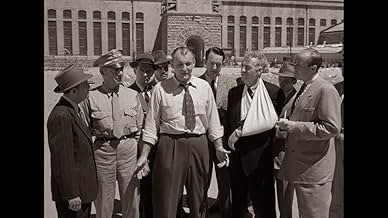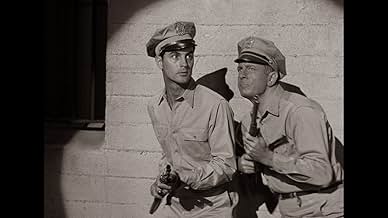अपनी भाषा में प्लॉट जोड़ेंFed up with the inhumane prison living conditions, a general prison riot breaks out, leading to hostage-taking, a stand-off with the guards and eventual negotiations with the prison administ... सभी पढ़ेंFed up with the inhumane prison living conditions, a general prison riot breaks out, leading to hostage-taking, a stand-off with the guards and eventual negotiations with the prison administration officials.Fed up with the inhumane prison living conditions, a general prison riot breaks out, leading to hostage-taking, a stand-off with the guards and eventual negotiations with the prison administration officials.
- 2 BAFTA अवार्ड के लिए नामांकित
- 3 कुल नामांकन
फ़ीचर्ड समीक्षाएं
The producer Walter Wanger (known for Ford's "Stagecoach" and Hitchcock's "Foreign Correspondent") had recently been in prison for shooting his wife's lover, and his experience there motivated this production. The film was shot on location at Folsom State Prison with real inmates and guards playing background roles.
"Riot in Cell Block 11" was the first film work for Sam Peckinpah, who was hired as a third assistant casting director by Don Siegel. Wanger and Siegel would team up again two years later for "Invasion of the Body Snatchers".
The Criterion release is a must-have, with plenty of background information on those involved, the inspiration, related writings and an excellent audio commentary from a noted film historian.
The resulting 1954 80 minute gritty drama, almost an unprecedented certificate 15, even now, was directed by Don Siegel. Following a popular format in those days, it starts off with a social documentary approach, complete with concerned voice-over - that this is a public announcement, part expose, part drama. It is not based on fact, at least not from one singular incident.
As you might expect, we follow prison guards (my title is the warning given to them, as they arm-up to thwart the riot), politicians and those who shape policy and of course, a handful of inmates. These provide everyday backbone; their tales are simple and uncomplicated and it's impossible to not side with them, or at least their plight. As ring- leaders take guards hostage, it becomes a nail-biting cat and mouse scenario, with Dunn (Neville Brand) producing ultimatums. Warden Emile Meyer wants negotiation, state officials want only swift force.
The film is well made and tautly directed, efficient but doesn't feel rushed. The version I saw on TCM (Turner Classic Movies) had a slight green cast but was generally good. I imagine that Riot In would have been compelling and possibly controversial viewing for cinema goers. It would have found favour especially amongst those who liked the hard crime film-noir type of dramas of the day, but without any of the glamour of femme fetales.
My guess is that whilst many prison dramas had been made at this point, they were character-lead and not out to socially comment. This would have been as hard-hitting as any TV '60 Minute' (etc) documentary and because it's still a good and credible film, it's still within the public domain, though is rarely shown and expensive to buy.
Cell Block 11 in this particular prison is the solitary ward, the place where the toughest cases are assigned. With a pair like Neville Brand and Leo Gordon in that block would you think otherwise.
Anyway to protest the conditions they're in the prisoners led by Brand stage a riot where they take the guards assigned to that block hostage. When Brand is wounded in a quarrel, Leo Gordon takes over leadership and he's belonging in the psycho ward. But he's the toughest guy in the joint and nobody is going to argue with him.
Emile Meyer does a great job as the warden who is a decent and compassionate individual trying to affect a few reforms. His pleas fall on deaf ears because then as now, convicts don't have any votes and by definition they are an anti-societal group. Meyer's humanity is contrasted with that of Frank Faylen who is a political appointee and tries a grandstand play with the convicts that almost gets him killed.
This is as realistic a prison drama as you will ever get. Big accolades go here to Walter Wanger who had an incredible unique perspective of life on the inside and turned it with Don Siegel's help into a great motion picture.
The storyline starts quickly with a group of prisoners taking their warders hostage and barricading themselves in their cell block. Narrative then follows the proceedings to their conclusion, the action never straying from the prison itself.
Film succeeds mainly as a result of not having any forced characters - none of the prisoners are particularly likable and there are none of the usual dumb characterisations usually found in prison movies. The various authority figures deal with the situation they are presented with in a matter of fact way, and the films stark style remains through to the end.
As I was watching 'Riot in Cell Block 11' I was dreading some wise old sage prisoner coming out of the woodwork, due for parole the following week, who was somehow going to contrive to get himself shot just as the riot was coming to a close, to enjoy a lengthy death scene in someone's arms. Thank goodness nothing like this occurs.
Film made me think of 'Killer's Kiss', in that they are both 1950's low-budget movies with great potential, from a soon-to-be famous director. 'Riot in Cell Block 11' succeeds in all areas, and while its targets may be low it certainly deserves more recognition.
As far as prison pictures go - This gritty, low-budget, tough-guy tale (though mighty tame by today's standards) still packed a substantial wallop even without a non-stop barrage of profanity and bloodshed.
Filmed (in b&w) on location at Folsom State Prison, California - This particular picture is notable for being one of the first in its genre to have the disgruntled convicts manipulate the media in order to make their grievances about prison conditions known to the public.
Yes. This picture featured typical, prison stereotypes. And, yes, it contained its fair share of unintentional humour, as well - But, all the same - (With its fast-paced, 80-minute running time) - It was still well-worth a view.
"Riot In Cell Block 11" (which was produced on a $300,000 budget) was directed by Don Siegel, who would later go on to direct Clint Eastwood in 1971's Dirty Harry.
क्या आपको पता है
- ट्रिवियाLeo Gordon had served five years for armed robbery at San Quentin State Prison. For this reason, Heinze, the Folsom warden, originally objected to Gordon appearing in the film, but director Don Siegel was able to convince him that Gordon was no threat to the prison.
- गूफ़When the state police force the convicts back into the prison by launching a barrage of tear gas at them, the police move forward, into the area being bombarded. The convicts are overcome by the gas, but the police aren't - even though they're not wearing gas masks and are enshrouded by the same gas the convicts are.
- भाव
Warden Reynolds: I promise you no harm will come to you during this conversation. Guard! These are my instructions. Dunn is to be allowed to come into this yard and return to 11 without interference.
- क्रेज़ी क्रेडिटThe following acknowledgment appears after the opening credits: "We wish to thank Mr. Richard A. McGee and his staff of the California Department of Corrections, Warden Heinze, Associate Warden Ryan, Correctional officers and the inmates of Folsom Prison for their co-operation."
टॉप पसंद
- How long is Riot in Cell Block 11?Alexa द्वारा संचालित
विवरण
- रिलीज़ की तारीख़
- कंट्री ऑफ़ ओरिजिन
- भाषा
- इस रूप में भी जाना जाता है
- Terror in Block 11
- फ़िल्माने की जगहें
- उत्पादन कंपनी
- IMDbPro पर और कंपनी क्रेडिट देखें
बॉक्स ऑफ़िस
- बजट
- $2,98,780(अनुमानित)
- चलने की अवधि1 घंटा 20 मिनट
- रंग
- पक्ष अनुपात
- 1.37 : 1
इस पेज में योगदान दें



































